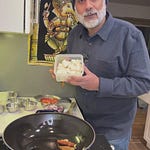Dear EasyIndianFood lovers,
Many of you have written in requesting EasyIndianFood how-to videos for your favorite Indian dishes, and I intend to respond to each and every one of you with a custom video, which I hope will not only be enjoyed by you — but by everyone.
In this first ever subscriber-inspired video cooking lesson, inspired by
’s request, I give you Paneer. I'd be lying if I said this one was easy...but, as I said at the end of the video, it’s still worth it if you’re feeding someone you love...It’s a bit labor intensive but not that hard to do. Like I say to my daughters when I over-butter their morning toast, “the more butter, the more love…” which is kind of the same thing with paneer: “the more effort in the cooking, the more love…”Paneer is a special food in Indian cuisine. It is not something you’d necessarily make at home in Banaras, where I was a student in the 90’s. It’d be much easier to walk out to one of the corner sweet stores that make fresh paneer in abundance every day. It’s not cheap either, since making paneer requires a lot of milk. Partly because it’s an expensive treat, paneer dishes are saved for special occasions like weddings or when special guests come to visit. So paneer is kind of a big deal in Indian cooking.
By the way, paneer is just one of the sweetmakers’s many specialties. They also make all kinds of achingly sweet creations in those stores, everything from Jalebi to Kheer-ka-dam, to Barfi (my favorite), and more. Almost all of the sweets are milk-based. The sweetmakers have huge cooking vessels, usually planted at the front of the establishment. They boil gallons and gallons of milk. Extraordinarily large scoops of sugar are mixed in with rose water, pistachio, and cardamom flavorings.
At home here in the United States, of course, you can’t walk down to the sweet store. You might be able to buy a block of paneer at a fancy-shmancy grocery store like Whole Foods or a specialty grocer. Or, if you live in a place with an Indian Grocery Store, you’d go there. Oddly, there was only ever 1-2 such stores the entire 15 years I lived in San Francisco — you’d think there would be more. I now live in a place that has a big Indian population, and I think we must have at least 10-12 in a 5 mile radius from my house. But the paneer you’re going to get is a shrink-wrapped brick. It’s ok. If that’s all you have - but not great.
Really fresh paneer is kind of like fresh Mozzarella di Bufala - a much creamier and lighter texture than the store-bought stuff if you choose not to extract too much of the moisture in the finishing process (one of two ideal ways to make it). I showed you how to make it that way in the video, but as you’ll see, I went the second route and extracted more water to make it denser. Both ways are good, and many recipes will use the less-dense version, but I plan to use this batch to make Saag Paneer tomorrow, where inevitably it moves around a lot in the pan. A denser texture survives me beating it up, and I don’t want the paneer to break up too much. But if you drop it in a different dish, Paneer Bhurji or a kathi roll, for examplie — the creamier texture version works (it’s also less work to worry less about removing so much of the moisture).
I’m looking forward to hearing your comments and feedback, and if you have an EasyIndianFood dish on your mind that you’d like me to make, please request it in the comments. And, do me a favor, share this with a friend or someone else you love : - ).














Share this post